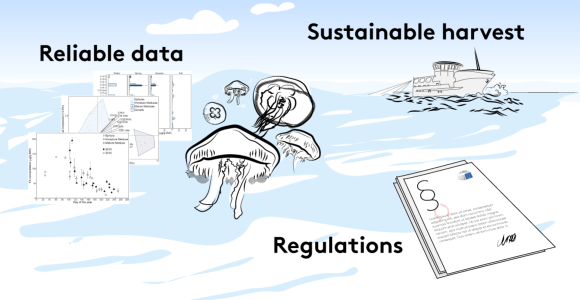Abstract
As adapting to climate change is becoming a high priority issue on policy-making agendas, there is growing interest and demand in using jellyfish as a potential fishery resource to support climate change adaptation. Prior to implementing such a strategy, however, it will be necessary characterize the available biomass, identify tools to locate jellyfish blooms and develop a process to utilize jellyfish catch/bycatch. Accordingly, we urge fishery policy-makers and advisors to consider jellyfish fisheries as a climate-responsive resource to address the challenges of the Ocean Decade and achieve the goals of sustainable development.
One-sentence summary: Jellyfish fisheries and bycatch on the policy-making agenda.

Global oceans are currently experencing concerning increases in multiple pressures, such as increasing temperatures, acidification, and overfishing, causing significant alterations in trophic relationships12. Thus, certain ocean regions are witnessing remarkable surges in jellyfish populations34.
These blooms can consist of immense biomass, posing a considerable threat to fishing grounds and other ocean systems. While the proliferation of jellyfish populations may be perceived as a negative consequence of ocean environmental change, the perceived abundance can also have positive implications for ecosystems, including key contributions to marine ecosystem services and functions. For instance, jellyfish provide food for certain species of fish and sea turtles, and they can aid in nutrient cycling and ocean carbon sequestration5.
Although scientists warn that fishing jellyfish will not resolve the issue of enhanced food demand from increasing populations, citing economic and ecosystem uncertainties6, jellyfish biomass has recently been utilized in a range of food and nonfood products, indicating that it could be a potential resource for the future7,8,9.
As various jellyfish products are introduced to the market, the demand for jellyfish biomass will inevitably increase. This biomass can be sourced from bycatch during routine fishery operations, large-scale jellyfish fisheries, or the jellyfish aquaculture industry10,11. Accordingy, it is crucial to ensure the responsible harvesting of this valuable marine resource. Therefore, we strongly urge policy-makers to proactively establish sustainable value chains and promote sustainable blue growth before unsustainable practices become established.
Achieving this goal will require a stepwise approach. First, reliable data must be collected to conduct jellyfish stock assessments and prioritize species suitable for commercial use. These data can be obtained from jellyfish bycatch, which is rarely reported and quantified in finfish fisheries. It could also be collected using novel approaches such as citizen science apps, drones using AI and machine learning, and long-term monitoring systems.
Second, to sustainably harvest jellyfish, modular supply chains that meet ecosystem-based fisheries management criteria must be designed to adjust harvesting practices to seasonal dynamics, thus ensuring long-term availability and preserving socioeconomic and ecosystem integrity. For instance, it is already possible to cultivate jellyfish through integrated multitrophic aquaculture, as hatchery-reared juvenile jellyfish are used in restocking or stock enhancement programs for fishery purposes and for farming in integrated multitrophic aquaculture systems . However, it is crucial to use scientific knowledge to guide seeding in both aquaculture tanks and the wild to prevent the unsustainable exploitation of jellyfish populations. Infrastructure and harvesting technologies should be adapted, and landing sites should have tools for forecasting jellyfish blooms and processing the catches immediately. Additionally, suitable transformation processes should be validated and ready, and off-season storage is necessary.
Last, it is essential that regulations for the jellyfish industry be established to ensure sustainability at all supply chain stages, from fishing to consumption, including the introduction of circular economic principles involving the appropriate use of production chain byproducts. This approach will involve implementing the Novel Food Regulation, which guarantees the safety, edibility, quality, and palatability of jellyfish intended for consumption. In addition, continuous monitoring of nascent production processes will aid in the identification of even weak signals of risk. Such regulations are necessary to prevent risks to consumers and the unsustainable exploitation of jellyfish if they become a highly in-demand resource and to ensure long-term availability.